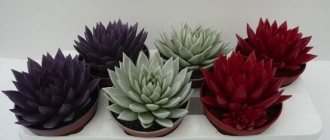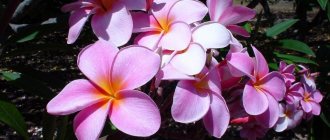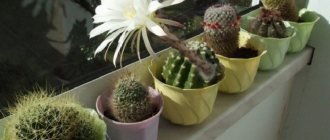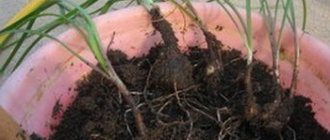- Pereskia: flowering leaf cactus
- Description of the pereska plant
- Types of indoor Persky
- Growing conditions for indoor Peresian
- Lighting and placement
- Temperature and ventilation
- Caring for Pereskaya at home
- Watering and air humidity
- Top dressing and fertilizer composition
- Trimming and shaping pereski
- Transplantation, containers and substrate
- Diseases, pests and problems in growing
- Peresian breeding
- Video: Pereskia - an amazing deciduous cactus
Pereskia: flowering leaf cactus
The status of the most ancient cacti among Peresk is disputed, but they are definitely the most original. Unusual bushes with real leaves and romantic flowering are difficult to mistake for relatives of the usual indoor cacti. Dangerous and beautiful spines only emphasize how extravagant this plant is. Not the most undemanding of conditions, pereskias easily shed their legendary leaves. But they still remain easy-to-grow succulents that can easily add variety to home collections.
Pereskia is a flowering deciduous cactus.
Diseases and harmful pests
The main disadvantage of this variety of cacti is their vulnerability to excess moisture. It provokes rotting of the root collar. The main reason for this manifestation is loose soil.
Quite often, the plant is attacked by gray rot. It appears in certain areas of decorative crops. If appropriate measures are not taken, the likelihood of the flower dying increases. The photo of Pereskia shows infected areas of the cactus.
Description of the pereska plant
Representatives of the Peresky genus are considered relict and perhaps the most ancient cacti - unusually bright flowering, dangerous spines and graceful leaves. They are allocated to a special subfamily of Pereskieves (Pereskioideae) and are found in nature only in Latin America.
Pereskia are often used as rootstocks for other types of cactus. In Brazil you can enjoy their buds, leaves and a special delicacy - aromatic, unusual, very tasty fruits known as Barbados gooseberries and climbing lemons.
Pereskia, or Peireskia (Pereskia) are distinctive representatives of cacti. These shrubs and trees in nature can reach gigantic sizes and are able to survive in the harshest conditions, storing moisture in the stems. But outwardly they are much closer to herbaceous plants - with deep roots and thin, branched, woody stems. Hidden in the axils of the leaves are beautiful areoles with very large, sharp and hard spines - single or collected in bunches, silver or dark brown.
The true leaves of Peresk are lanceolate-oval, with a pointed tip, reminiscent of laurel leaves. With a length of up to 10 cm, they are shiny, leathery, with different shades of green among species and varieties. They fall off in uncomfortable conditions and during periods of rest, and often fade.
The summer flowering of Pereschi is reminiscent of wild roses and roses thanks to the delicacy of the petals and the lush hemisphere of bright stamens around the very large pistil. Flowers are from 4 cm in diameter, solitary or collected in inflorescences, fragrant, with delicate cream or pink colors.
After flowering, edible, yellowish-reddened fruit cones, up to 2 cm in diameter, begin to develop. Some pereskias can compete with prickly pears in the originality of fruiting, forming entire clusters. After the fruit begins to ripen, the hidden areoles on it begin to swell and grow into new buds or side shoots, as if the fruit is branching at the top.
Pereskia grandiflora.
Botanical description
Pereskia godseffiana has thin stems with black spines growing in tufts. Despite the fact that this plant belongs to the cactus family, the leaves are not spines, but solid leaf blades up to 6 cm long. The lower leaves have a pinkish or purple tint.
During flowering, it forms medium-sized white or cream-colored flowers . Can grow up to 10 meters tall. Basically, this plant does not use other trees for support and is not a vine, but sometimes uses supports for its further growth in height. This type is not suitable for use in vertical gardens.
The homeland of this plant is considered to be Central and South America, steppe or transitional to steppe climatic zones. The first mention of this cactus was recorded in 1703. It was only in 1754 that this plant was classified as a member of the Cactus family.
Types of indoor Persky
Pereskia orange (Pereskia bleo) is a plant with oval, large, matte leaves decorated with a wavy edge and flowers reminiscent of red-orange roses, followed by bright cones of inedible fruits.
Pereskia aculeata is a climbing species that forms very dense bushes with large lanceolate leaves and long spines. Rosehip-like, fragrant, wide-open, pale cream flowers with bright orange stamens cover the bush in a scattering. There are many forms and varieties with reddish leaves.
Webber's Pereskia weberiana.
Pereskia aculeata.
Pereskia grandifolia.
grandiflora is prized for its soft pink, large flowers in clusters of inflorescences, highlighted by dark leaves and very long spines.
Webber's Pereskia weberiana is a very beautiful, densely branching species that is easy to form. Small, bright oval leaves and abundant blooms with snow-white flowers seem strikingly romantic.
In Pereskia, the most outlandish fruits can be found in Pereskia grandifolia, with its fruit clusters consisting of ovaries and stems with intricately curved purple flowers.
Pereskia leaf cactus: what species are grown in pots
In Pereskia culture it grows to a maximum of 1.8 m, never reaching a height of 6-10 m; you can only read or see about a trunk with a diameter of “at least” 10-15 cm in Latin America. Several species can be grown as a potted plant.
Prickly (Prickly, Barbados gooseberry)
Pereskia aculeata and P. godseffiana are often positioned as different species; in fact, they are synonyms. More precisely, Pereskia aculeata var. Godseffiana, Godseff's perescia, is not an independent species, but is a variety of Spiny, that is, a taxon of lower rank.
In cultivation it resembles a vine with a cranked stem. Can be grown as an upright plant or on a support. Sometimes young stems are bent down to form an ampel.
In nature it reaches a height of 3-10 m with a trunk diameter of up to 30 cm, at home - no more than 180 and 1.5 cm, respectively. The leaves are oblong-oval, up to 9 cm long, about 4 cm wide.
Over time, the lower part of the trunk becomes bare, the leaves fly off, but areoles with 1-3 spines remain.
The original type has green plates; the Godseff variety boasts leaves:
- golden on the front side;
- the underside may be green or reddish.
The flowering of Pereskia Prickly Rose does not resemble the rosehip. Corollas:
- such as most cacti, only without a hint of a tube;
- petals are relatively narrow, white;
- the stamens are large, numerous, bright orange.
The fruits are edible and taste similar to unripe gooseberries. Diameter – 1.5-2.5 cm.
Large-leaved (Grandifolia)
Pereskia grandifolia grows up to 5 m in nature, but at home it grows much lower. It is distinguished by large (9-27 cm) light green leaves with a wavy edge. The flowers are very similar to rose hips, lilac-pink. Needles 3 cm.
Bleo (Orange)
Pereskia bleo in its homeland reaches 2-6 m with a trunk girth of 15 cm. The leaves are elliptical, from 6 to 20 cm. The species is different:
- red-orange flowers, similar to semi-double camellia;
- inedible fruits of an original cone shape.
Weber
Pereskia weberiana grows up to 3 m in nature. Unlike other species, it blooms from March to June. The flowers are white, the stamens are yellow, about 1 cm in diameter. The petals deviate in different directions, resembling drops turned inward with their sharp tip.
Growing conditions for indoor Peresian
In order not to be disappointed in this unusual cactus, you should approach the selection of conditions with the utmost care. If you provide your Pereski with access to fresh air, the warmth she loves, and bright lighting, there will be no problems with care.
Lighting and placement
Pereskia are among the most light-loving cacti; they do not welcome artificial lighting and bloom only on sunny windowsills. You can even place them on south-facing windows. Direct summer sun will often burn the leaves, but simply moving them away from the glass or moving them to a spot next to a windowsill in high summer will easily correct this problem. In partial shade, the bushes stretch out and do not bloom.
Maintaining the level of lighting for the winter and moving it to a bright window sill is one of the conditions that allows pereskias not to lose all their leaves.
Temperature and ventilation
Pereskias love fresh air. Drafts are not dangerous (unless there is a sharp jump in temperature and the plant does not bloom). It is necessary to ventilate the premises as often as possible. Whenever possible, it is better to place pereskias in the fresh air, choosing warm places protected from precipitation.
In summer, Pereskias feel great in the warmth. When kept indoors, it is better to maintain a temperature of 21 to 23 degrees. In the fresh air or with constant ventilation, pereskias can withstand any heat.
The ideal temperature for wintering pereski is considered to be about 15 degrees Celsius. The temperature should not drop below 10 degrees. Increasing the indicators to the usual indoor ones requires control of lighting, frequent ventilation and impeccable care.
Orange Pereskia (Pereskia bleo).
Kinds
There are a total of 17 species of Pereschia spinosa. In natural conditions, they all grow quite large, although when grown indoors they are very beautiful, compact bushes. The most popular among flower growers is Pereskia thorny. This plant forms a spreading, tall bush. The stems are covered with hooked, short spines and are quite strongly branched. The short-petioled leaves are 9 centimeters long and 4 centimeters wide. The foliage is bright green and quite tough. The plant blooms with large flowers that have a strong aroma. In this case, the fruit resembles a gooseberry, as mentioned above.
Caring for Pereskaya at home
Careful watering, rare fertilizing and attention - these are all the measures that pereskias need to maintain their decorative appearance.
Watering and air humidity
For pereskia, active watering is carried out only during the growth period, but it is better not to completely dry out the substrate even in winter, because during drought, pereskia sheds its leaves. In spring and summer, the soil is allowed to dry in the upper third of the pot, immediately draining the excess from the trays. In winter, watering is reduced. You need to change the humidity gradually.
Despite the dislike of high air humidity, to maintain the decorative appearance of the leaves, it is better to include “refreshing” sprays with warm water in the care of pereskies. The higher the air temperature, the more often they need to be carried out, up to daily in the summer. Dust is removed by washing the leaves; wiping destroys the protective coating.
Top dressing and fertilizer composition
Fertilizers are applied to this cactus only in liquid form and only during the period of active growth. One feeding per month with special fertilizers for succulents and cacti is enough.
Trimming and shaping pereski
Even bonsai can be easily formed from Pereskaya. They tolerate pruning well in spring and summer, provided that at least 1-2 internodes are left on the shoots.
Young pereskias can be replanted several times a year.
Transplantation, containers and substrate
Pereskia requires a very loose substrate with a pH of about 7.0. To the usual soil mixture for cacti and succulents, it is worth adding 40-50% loosening additives that guarantee high air permeability of the soil (coarse sand, perlite, stone chips, gravel).
This cactus is replanted only as needed - as soon as the roots fill the space of the pot. Young cacti can be replanted several times a year; adults often do not need to be “touched” for several years.
For Pereskaya, fairly deep containers are used, corresponding to the unusually powerful root system for cacti. A high drainage layer is required.
Pereskia do not tolerate contact with roots; they are carefully handled. Watering after transplantation should be extremely careful until rapid growth begins.
Reproduction of Pereskia
Pereskia is propagated by seed and cuttings. Pereskia seeds are sown in the spring in a container with loose substrate and kept until germination at a temperature of 20-22 ºC. When the seeds germinate, the crops are placed in a bright, warm place, but at first they are protected from direct sunlight. Strengthened and grown seedlings are planted in separate pots.
For the cutting procedure in spring or summer, cuttings are cut from the stems of Pereska, planted in a peat or perlite substrate and covered with a transparent cap to create greenhouse conditions. Rooting occurs best at a temperature of 25-28 ºC. You can grow roots by placing the cuttings not in the substrate, but in a container with water: under such conditions, roots will appear within three weeks. Rooted cuttings are planted in pots.
Diseases, pests and problems in growing
Pereskia are one of the most sensitive cacti to waterlogging and are extremely susceptible to rot. If there are any signs of damage to the stems, root collar or roots, you must immediately adjust the conditions and care and begin treating with fungicides. An emergency transplant most often leads to death.
Of the pests, all insects that love dry conditions are terrible for the Peresian - spider mites, mealybugs and thrips. It is better to fight them immediately with insecticides.
Fading or dropping leaves, stretching shoots always indicate an excess or lack of light. Growth disturbances most often occur due to irregularities in watering.
At home, pereskia is most often propagated by stem cuttings.
Diseases and pests
This cactus has a fairly strong immune system. The main bacterial disease is gray rot, which appears when overwatering. In this case, you should transplant the cactus into a new pot and reduce watering.
Pests - spider mites and mealybugs . These pests cause severe damage to the plant; as soon as the first signs of pests appear, it is necessary to immediately rinse the cactus with a warm shower, protecting the soil from water.
A cotton swab soaked in an alcohol-containing solution will help remove scale insects from the plant. Advanced cases of plant disease require treatment with special chemicals.
Peresian breeding
Growing pereskia from seeds is very difficult due to low germination and extreme sensitivity of seedlings to any increase in humidity. Sowing is carried out to a depth of 1 cm, in very light soil. At temperatures up to 21 degrees, plants are kept in light humidity under a hood. Diving is carried out very carefully in the 4-leaf phase, but it is better to sow directly into individual containers.
At home, pereskia is most often propagated by stem cuttings. You can cut them in spring and summer, using pieces of stems with 1-2 internodes. It is easier to root cuttings in sandy soil under a cover, at a temperature of 25 degrees. When rooting in water, you need to plant the cuttings very carefully, trying not to come into contact with the roots.
How does pereskia reproduce?
Gardeners use two methods of propagation: seeds and cuttings. Both methods help to obtain healthy and viable seedlings.
Germination of seeds
It begins with the preparation of boxes filled with sand and peat mixture. Sowing work is carried out in early spring; planted seeds require regular watering.
After planting, the containers are covered with plastic film, and the improvised greenhouse is periodically ventilated.
Important! If you care properly during this period, the first shoots will appear by the end of the month.
Rooting cuttings
Healthy shoots are selected for cuttings; the procedure is carried out in spring or June. The branches are cut into small cuttings, and the cut areas are treated with charcoal powder.
Later, the trimmings are placed in boxes with a perlite-peat mixture. The boxes are covered with polyethylene, periodically watered and ventilated.
Important! In a few weeks, young shoots will appear that can develop without film.
How to replant pereskia
The root system and the plant as a whole develop quickly, so young pereskias must be replanted annually in spring or early summer. Take a slightly larger container each time. Replant adult specimens as needed - when the roots begin to emerge from the drainage holes.
Handle it along with the clod of earth so as not to disturb the root system. For drainage, place pieces of clay shards, pebbles, and expanded clay on the bottom; the thickness of the layer should take up about ¼ of the total volume. Pour a little soil, roll over the flower, fill the rest of the space with substrate, leaving the root collar at the same level, press firmly at the surface with your palms so that the bush does not wobble.
The quality of the soil requires loose, light, medium nutritional value. It is prepared from leaf, clay-turf and humus soil with the addition of sand (ratio 2:2:2:1).
Growing
Cacti are considered rather unpretentious plants. They tolerate dry periods and temperature changes well. Many plant lovers grow them at home. Caring for Pereskaya is not difficult. When planting a plant in a room, you need to take into account that in artificial conditions the tree will be much lower than in nature. It will stretch to a maximum of one and a half meters.
Pereskia loves sunlight, but the young plant cannot be exposed to direct rays, as the leaves can get burned. Therefore, it is necessary to create a little shading. It is better to place the cactus on the south side, on the windowsill. In summer, it is recommended to take the flower pot out to the balcony so that it can get some air. If there is no balcony, in warm weather you need to ventilate the room well. On the dark side it is necessary to create additional lighting. Daylight hours should be at least 10 hours.
In summer, the favorable temperature regime for the cactus is within +22-25 degrees. In winter, the plant enters a dormant period. At this time, you need to lower the temperature to +14-15 degrees. It is important not to allow the degrees to drop below +10, as the tree may die. Air humidity does not need to be regulated, since in wild conditions Pereskia tolerates drought well. But it is still recommended to periodically irrigate the leaves with warm water.
Cacti do not need frequent watering. Pereskia is watered when the soil in the pot begins to dry out. In winter, this procedure is performed 1-2 times a month. The plant really does not like flooded soil. Use settled water at room temperature. You can take a rain one. Experienced gardeners advise feeding the tree once or twice every 30 days. It is better to take special fertilizers for cacti. In winter, the plant is not fed.
You can buy ready-made soil for seedlings or select it yourself. Garden soil, coarse sand, and crushed birch charcoal are suitable for this. Everything is mixed in equal proportions. You can add humus to the mixture. Pots should be chosen deep and wide, since the roots of the plant are quite powerful. The tree is replanted annually. If a cactus stops growing, it may be due to lack of space. You also need to monitor the shade of the foliage. The leaves turn pale from too much light, so you need to move the pot to a more shaded place or remove additional lamps. Elongation of shoots may begin due to lack of light (this happens in winter). In this case, you need to organize lighting.
Pereskia cactus is perfect for placing in your home. Its magnificent flowers will delight guests and family members. The positive energy of the plant protects against negative vibrations and aggression.
Main types
In total, there are 17 types of Pereskia throughout the world.
In the natural environment they grow quite large; in apartments and offices the pereskia bush looks like an ordinary decorative houseplant:
- Pereskia rosehip a very common subspecies of cacti. The plant grows tall. The stem is well developed, covered with small spines. The leaves grow up to 9 cm in length, their width is 4 cm, and the color is green. The flower is bright yellow or pink and has a strong aroma. The shape of the berries is similar to gooseberries.
- Godseff. This subspecies has a thin stem that is covered with long black spines. Lance-shaped leaves are attached to the trunk by short turtles. The leaf length is 6 cm, has a light green tint, and is bright green in the center. On the reverse side, the leaf has a pink color fading to a purple hue. They bloom in white or beige inflorescences.
- Orange Pereskia. The stem is underdeveloped and bears large leaves with a relief pattern. The flowers are orange with a hint of red, similar in size to poppy heads. Their diameter is 6 cm. The fruits of the plant are yellow, cone-shaped, and smell like pineapple.
- Pereskia grandiflora. This variety has the shape of a bush, densely covered with foliage. At a temperature of +10°C, this species sheds a small amount of foliage. The flowers are large and pink.
- Weber. Formed in the form of a small bush. During the flowering period, the plant produces abundant flowers from white inflorescences. Flowering occurs in April-August.











